Six U.S. Mint Error Coins You Should Know About
Posted on — 13 CommentsIn 2021, the U.S. Mint produced nearly 14.5 billion coins. Despite first-class technology and extensive quality control efforts, – some mistakes happen, – and these are known as error coins, or misstrikes.
Mint error coins are one of the most intriguing categories in numismatics. Collectors value these coins according to their scarcity, and the price is determined by supply and demand. The fewer misstrike or error coins produced, the more valuable those coins are today. In fact, misstrikes and error coins typically hold a higher value than a coin in its intended condition. Some of the rarest error coins are worth $150,000 or more.
Before we highlight six valuable mint error coins, let’s explain how a few common errors occur. The cause could be a defect in the manufacturing process or even simple human error. Common mint errors include such examples as a double-strike coin. You can see a good example of this in the second entry. These occur when a struck coin goes back into the press and is struck a second, or even third time. The more times a coin was struck the higher the potential value.
A planchet is a blank disc of metal created for coinage, which could be steel, silver, gold or other metal. An off-center coin error is one that was incorrectly centered and part of the design is missing. These errors occurred when the planchet was not inserted into the press correctly. A wrong planchet coin is created when a coin is struck on a planchet meant for another denomination, or on a planchet made of the wrong type of metal.
Now let’s dive into our list of six U.S. Mint error coins that still intrigue collectors today.
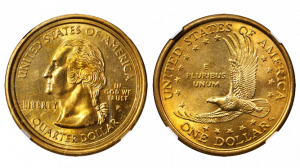
Sacagawea Dollar Reverse/Washington Quarter
In this example, the obverse design reveals a Washington quarter, while the reverse reveals a Sacagawea dollar. About two dozen of these major errors were struck at the Philadelphia Mint. These types of coins are called “mules” – coins struck using two dies intended for two different coins. Mules tend to be the Holy Grail of error coins because, while some are created intentionally, those that are true errors are exceptionally rare. This coin has sold for at least $31,600 in various auctions, and often for a great deal more by private collectors.
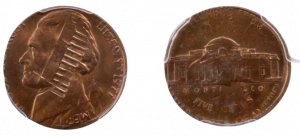
1977 Jefferson Nickel/1976 Lincoln Cent
This is a “double denomination” error (nickel and penny), and both dates are visible on the coin. You can also clearly see the Lincoln Memorial over-stamped on Jefferson’s face. These coins are fairly rare and sell for upwards of $3,000 in various auctions.
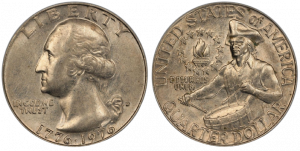
Washington Quarter Doubled Strike
This is a great example of a double – struck coin, presented with “off-center” strikes on both sides of the coin.
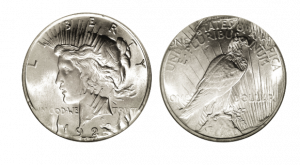
Peace Dollar Double-Strike
This formed when the coin was struck about 45% off center, but then re-positioned and struck a second time. There are many double- struck coins out there, but a double-struck Peace Dollar is a very rare find. In 2018, an example of this coin sold for over $5,000. It appeals to not only the advanced Peace Dollar collector, but the coin error collector as well.
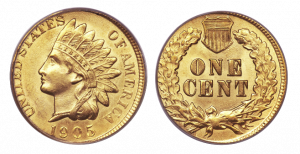
Indian Head Cent on a Quarter Eagle Planchet
Surprisingly, a gold quarter-eagle planchet was inserted into the cent- coining chamber. Due to the magnitude of this error, some numismatists suspect that this error was intentional. It would be surprising for a mint employee to accidentally feed gold planchets into a press fitted with one-cent dies. It’s far more likely that these were made for a small group of collectors. That said, we likely will never know for sure. This is one of the most valuable mint error coins available, with fewer than 10 known examples.
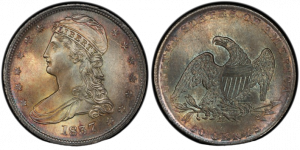
1837 Capped Bust Half Dollar
This error occurred when the coin was struck on a large cent, creating a double denomination. This error is fascinating and unique for both its series and date. In 1837, the steam press had been utilized to produce half dollars for only a little more than a year, and the coin was circulated before being placed into a collection.
This is just a short list of numerous minting errors that have occurred throughout history. Error and misstrikes coins hold a special place in the hearts of serious collectors. The appeal includes rarity, unusual appearance, and the perspective they provide into the coin- minting process. When these coins surface from collections at auction, they typically generate excitement and active bidding.
If you are interested in learning more about error coins or misstrikes, or are trying to source a specific coin, let us know. Blanchard and Company has tremendous reach and respect within the rare coin industry. If there is a particular coin or set that you are trying to build, our experts can help source your coins from collections around the world.
Want to read more? Subscribe to the Blanchard Newsletter and get our tales from the vault, our favorite stories from around the world and the latest tangible assets news delivered to your inbox weekly.
13 thoughts on “Six U.S. Mint Error Coins You Should Know About”
Comments are closed.










Thank you for sharing in your post the truth about mint errors in coins and that off-center coin error was incorrectly centered, and part of the design is missing. Since small, my father has liked collecting gold coins here in Illinois. He told me one day he wanted to sell some of it and wanted to know the value of each. It’s good that there is a company that helps him sell this kind of collection he has. The money has no dents or errors, so it might cost a fortune.
I have the same exact quarter as the one show the bicentennial the hands line up the same the fingers look the same the patch on the eye look the same the stars is all there,it’s DDO and DDR
Hi Sabrina!
That’s great news. This might be a good time to send your coin in to NGC or PCGS for grading!
A student of mine found a nickel that is only printed on the front and has no rim. How do we find out the value of this coin so he can make a decision about what he would like to do with it?
Hi Suze:
Because there are so many variables that go into determining the value of rare coins, we always suggest you go in person to a reputable coin dealer in your area. They’ll be able to see the coin and give you more information.
I have just started to collect coins with mistakes. I used to believe the rarity was how old the coins were. It’s more exciting finding the mistakes on ones yet to be discovered
I just found a 2022 D penny with the mint mark D above the date closer to Lincoln’s nose. Is this a common error or dud a fund an unusual coin?
Hi Michael. It might be worth your while to take this penny to a reputable coin dealer in your area. If there’s a mint mark on these pennies, it typically is below the date, so it would be interesting to find out what you have!
I have a Sacagewea dollar with NO date or mint mark. It has a Native American “harvesting corn” on the reverse.
Is there any value to this coin?
Hi Linda:
We suggest you take your coin to a well-respected coin dealer in your area. They’re a great resource because they can actually see your coin and get a better idea of what you have. Good luck!
I have 2015 d blue ridge quarter with a number 3 above the d mint mark
I have what appears to be Sacagawea Dollar Reverse/Washington Quarter w/ a Philadelphia Mint stamp, color is more like a rose gold than the standard gold print. I came across it about 10 years ago in perfect condition and have kept it in a protective sealed bag since then. How would I go about getting it authenticated & learn estimation of value?
Hi Tricia. You have a couple of options here. You can take your coin to a reputable dealer in your area and see if they can give you more information about it. You could also look into having it graded by PCGS or NCG and that would provide you with a better idea of what you have. Good luck!